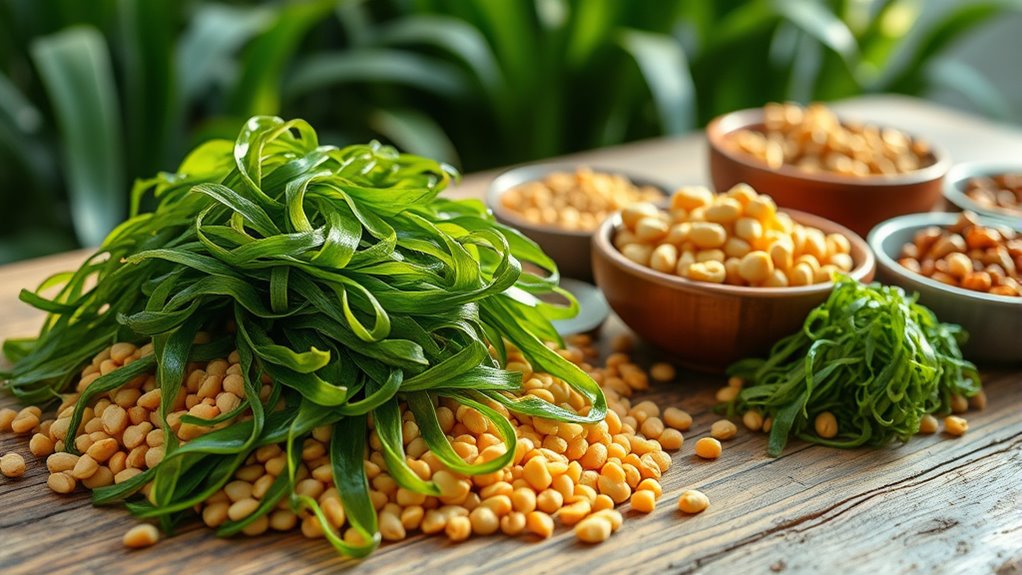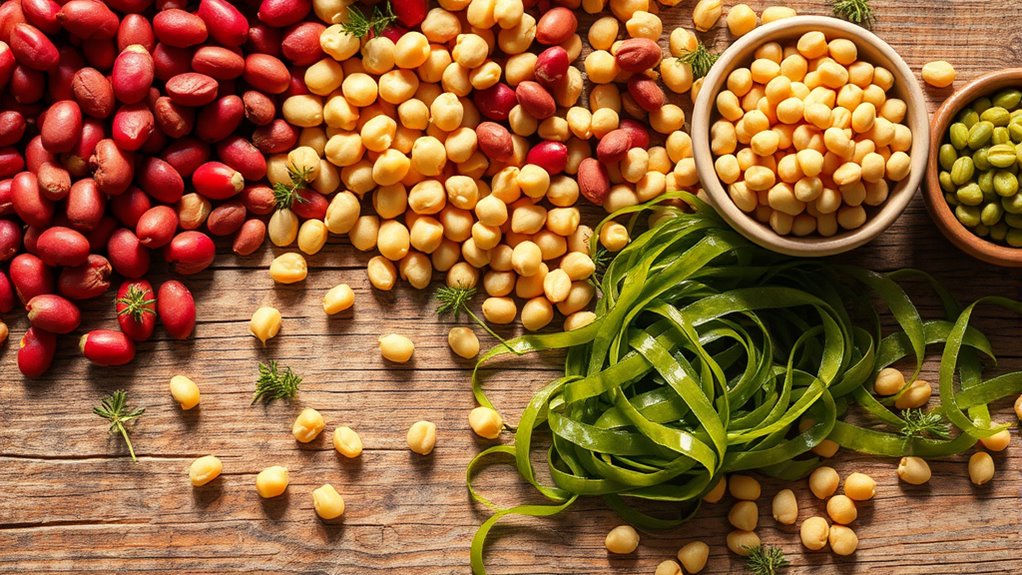Switching to sustainable proteins like pulses and seaweed helps you meet your nutritional needs while reducing environmental harm. Pulses such as lentils, chickpeas, and beans require less water and land, have a low carbon footprint, and are packed with valuable nutrients. Seaweed grows quickly with minimal resource use, absorbs CO₂, and offers essential nutrients like iodine and omega-3s. Exploring these options lets you make eco-friendly choices that benefit both your health and the planet. Keep exploring to discover more about these innovative sources.
Key Takeaways
- Pulses like lentils and chickpeas are eco-friendly protein sources requiring less water and land than traditional livestock.
- Seaweed grows rapidly with minimal land and freshwater, absorbing carbon dioxide and enriching marine ecosystems.
- Plant-based meat substitutes made from pulses provide sustainable and familiar protein options, reducing environmental impact.
- Incorporating seaweed into diets offers nutrients like iodine and omega-3s while supporting water quality and ecosystem health.
- Transitioning to plant-based proteins helps lower greenhouse gas emissions, mitigate deforestation, and promote a healthier planet.

Have you ever wondered how we can meet the growing global protein demand without harming the planet? The answer lies in embracing plant-based innovations that offer sustainable alternatives to traditional animal proteins. These innovations aren’t just about creating new foods; they’re about transforming the way we think about nutrition and environmental impact. By shifting toward plant-based proteins like pulses, legumes, and even seaweed, you can help reduce the strain on natural resources, lower greenhouse gas emissions, and promote a healthier planet. This shift is essential because livestock farming remains one of the largest contributors to environmental degradation, including deforestation, water consumption, and pollution. Plant-based innovations aim to address these issues by providing nutrient-dense, versatile, and eco-friendly options that fit seamlessly into your diet.
Pulses, such as lentils, chickpeas, and beans, are among the most promising developments in sustainable protein sources. They require considerably less water and land compared to traditional livestock, and they have a low carbon footprint. Incorporating more pulses into your meals means you’re making a conscious choice that benefits the environment. These foods are also rich in fiber, vitamins, and minerals, making them a nutritious addition to any diet. Plant-based innovations have made it easier than ever to enjoy tasty, hearty dishes that are good for you and the planet. For example, plant-based meat substitutes made from pulses or other legumes are now widely available, offering familiar textures and flavors with a fraction of the environmental impact.
Seaweed is another innovative solution gaining popularity. It’s a fast-growing, sustainable crop that absorbs carbon dioxide while requiring minimal land and freshwater. Seaweed can be incorporated into a variety of foods or used as a protein-rich supplement, providing essential nutrients like iodine, omega-3 fatty acids, and antioxidants. Its environmental impact is minimal, making it an excellent choice for reducing your ecological footprint. Plus, seaweed farming can even help restore marine ecosystems and improve water quality.
Frequently Asked Questions
How Does Pulse Cultivation Impact Soil Health?
When you cultivate pulses, you improve soil health through soil enrichment, as they fix nitrogen naturally, reducing the need for synthetic fertilizers. Incorporating pulses into crop rotation helps break pest cycles and prevents soil depletion, maintaining fertility over time. This sustainable practice enhances soil structure, boosts organic matter, and promotes a healthier ecosystem, making your land more productive and resilient for future planting.
Are Seaweed Products Safe for Daily Consumption?
Seaweed products are generally safe for daily consumption when sourced from reputable providers. Seaweed safety depends on proper harvesting and processing, which guarantees they’re free from heavy metals and contaminants. If you stick to moderate amounts, you won’t risk overexposure to iodine or other minerals. Always check product labels and consult healthcare providers if you have thyroid issues or other health concerns, and enjoy seaweed as part of a balanced diet.
What Is the Environmental Footprint of Plant-Based Proteins?
You might be surprised to learn that plant-based proteins typically have a 30-50% smaller carbon footprint than animal proteins. They also use considerably less water—sometimes up to 90% less. This means choosing plant-based options helps reduce greenhouse gases and conserves precious water resources. By switching, you directly contribute to lowering environmental impact, making a positive difference for our planet’s health and sustainability.
Can Sustainable Proteins Meet Global Food Demand?
Yes, sustainable proteins can meet global food demand, but success depends on your acceptance of innovations like genetic modification. Advances in genetically modified crops and alternative sources such as pulses and seaweed can boost production efficiently. However, consumer acceptance remains vital; if you’re open to these options, they can help address food security while reducing environmental impact. Embracing both technology and diverse protein sources is key to future sustainability.
How Do Prices of Alternative Proteins Compare to Traditional Meat?
Prices of alternative proteins are becoming more like steady waves than unpredictable storms, showing a downward trend in recent years. You’ll find market affordability improving as production scales up and technology advances, making plant-based and seaweed options more accessible. While traditional meat still holds a price advantage in some areas, the gap is narrowing, offering you more budget-friendly choices without sacrificing taste or sustainability.
Conclusion
As you explore sustainable protein options like pulses and seaweed, remember that switching to plant-based sources can reduce your carbon footprint markedly. Did you know that producing one kilogram of pulses emits up to 90% less greenhouse gases than beef? By making small changes in your diet, you contribute to a healthier planet. Embracing these alternatives not only benefits the environment but also supports a more resilient food system for future generations.
Ilana has been a vegan for over 10 years. She originally made the switch for health reasons, but soon found herself becoming more and more passionate about the ethical and environmental implications of a vegan lifestyle. Ilana is the author of The Graceful Kitchen, a blog all about veganism. She loves to cook up delicious and nutritious vegan meals, and share her recipes with others who are interested in leading a cruelty-free life. Ilana is also a strong advocate for using whole foods as the foundation of a healthy diet, and believes that going vegan is one of the best ways to achieve this.










